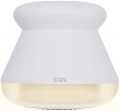Brush for cleaning
The brush is convenient for cleaning the blades and other elements of the remover from waste that inevitably occurs during operation. Of course, other devices can also be used for this, but in general, complete brushes are considered the most convenient and practical option: they are quite effective, and the risk of damage to remover parts is minimal.
Container
The lint Remover uses container to gather production waste, with the container size based on the expected workload. Opt for a larger capacity for furniture cleaning and a smaller one for processing small items. Transparent walls facilitate monitoring the fill level, and a
removable container simplifies waste disposal, making it more convenient than non-removable alternatives.
Charging time
The time required to fully charge the battery (from zero to 100%) in properly powered lint removers (see above). This information allows you to estimate how long pauses in work will be required to charge the battery. (Although some models, supplemented by mains power, are able to work while charging).
Charge indicator
The presence of a
charge indicator in the design of a battery-powered lint removers (see above). Such an indicator is usually light, and the format of its operation may be different. So, in some models, it signals that the device has been successfully connected to a power source and the charging process is in progress, in others it reports the end of the process, in others, these features are combined (for example, the LED lights up during charging and goes out when it ends); may provide displaying the current charge level, etc. However, this feature simplifies the maintenance of a battery-powered remover, and it has almost no effect on the price anyway.

